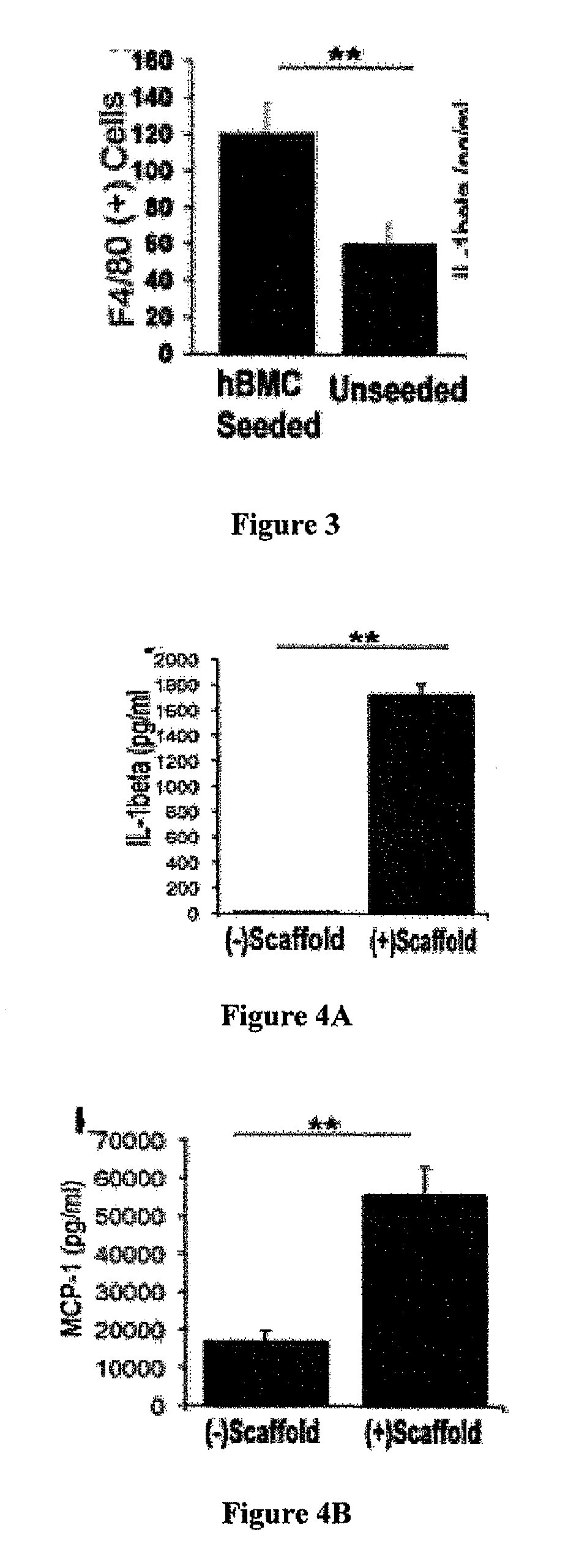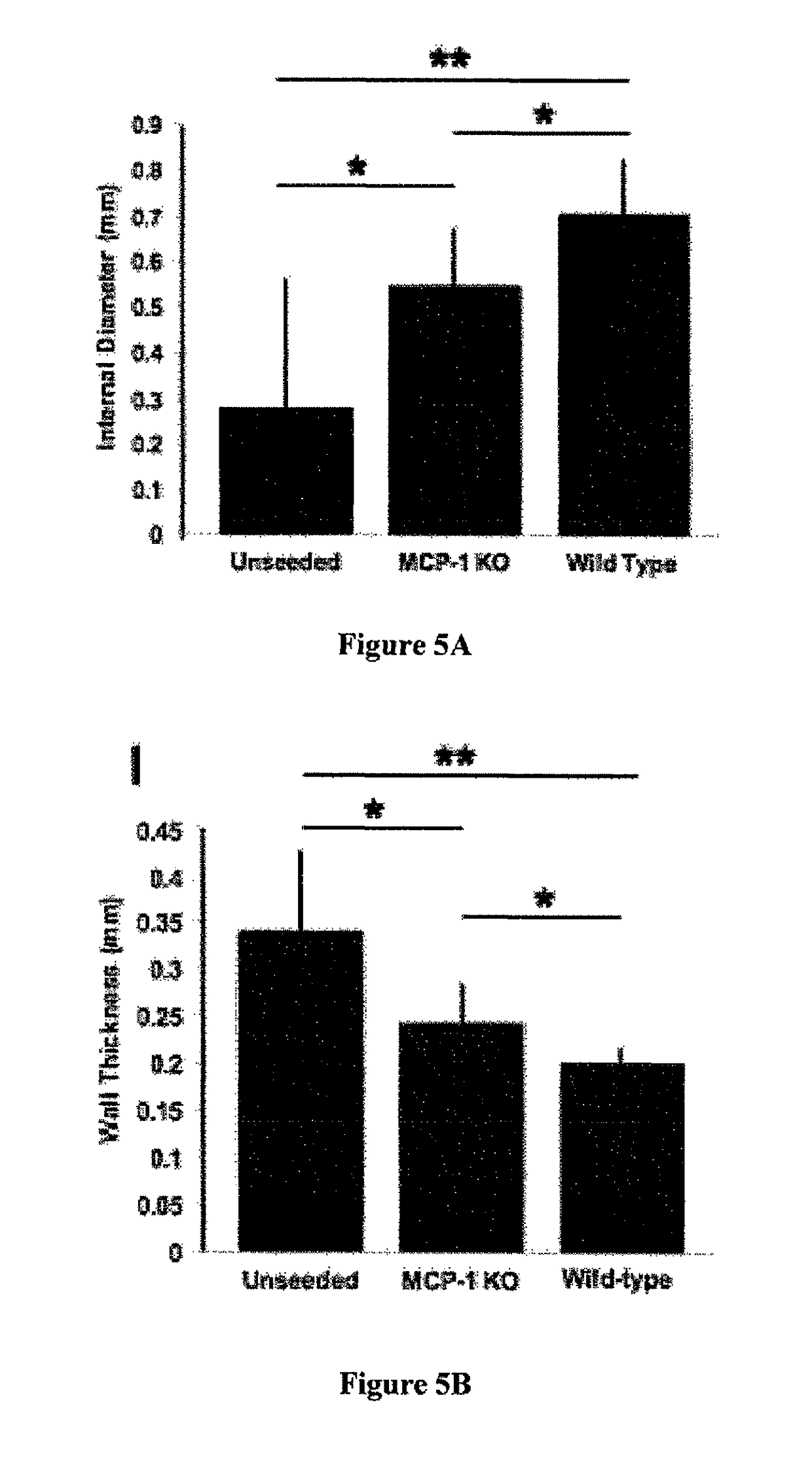Compositions and methods for promoting patency of vascular grafts
a vascular graft and patency technology, applied in the field of compositions and methods for increasing the patency of vascular grafts, can solve the problems of increased contamination risk, increased risk of contamination, and increased difficulty in obtaining healthy autologous cells from diseased donors, and achieve the effect of increasing patency
- Summary
- Abstract
- Description
- Claims
- Application Information
AI Technical Summary
Benefits of technology
Problems solved by technology
Method used
Image
Examples
example 1
man Bone Marrow Mononuclear Cells (hBMCs) Improve the Functional Outcome and Vascular Development of TEVG
[0085]Materials and Methods:
[0086]Biodegradable PGA-P(CL / LA) Scaffold Construction
[0087]A dual cylinder chamber molding system was constructed from a 6.5 mm diameter polypropylene rod. A 1.4 mm diameter inner cylinder was cored through the center of the rod for a length of 30 mm and gradually tapered out to 6.0 mm at the inlet. Polyglycolic acid (PGA) nonwoven felt (ConcordiaFibers, Coventry, R.I.) was used for the framework of the scaffold. Felts were 300 mm thick with approximately 90% (PGA) or 83% (PLLA) total porosity. The gradual taper of the inner cylinder enabled flat felt sections (6.0 mm×4.0 mm) to be easily shaped into tubes during their insertion through the inlet of the dual cylinder chamber system. Stainless steel needles (21 g) were then introduced into the opposing end to maintain the inner lumen and further compress the felt. A 50:50 copolymer sealant solution of ...
example 2
s Constitute a Minor Fraction of Seeded hBMCs
[0105]Materials and Methods:
[0106]Materials and methods were as described in Example 1 except as described below.
[0107]Characterization of hBMCs
[0108]Flow cytometry was used to identify and quantify sub-populations in the mononuclear cell fraction of human bone marrow. Human BMC from five different donors were used and tested in triplicate. Antibodies used were purchased from BD Biosciences CD8 PerCP(SK1), CD14 FITC (M5E2), CD31 FITC (WM59), CD34 PE and PerCP-Cy5.5 (8G12), CD45 APC-Cy7 (2D1), CD56 PE (NCAM16.2), CD146 (P1H12), CD73 PE (AD2), CD90 FITC (5E10), 7AAD; E-Bioscience CD3 APC (HIT3a), CD4 FITC (L3T4), CD19 (PE-Cy7); Miltenyi Biotec CD133 APC (AC133); R&D Systems VEGFR2PE (89106); and AbD Serotec CD105 Alexa 647 (SN6). Cells were acquired on a FACSAria cell sorter and results analyzed using DIVA software (BD Bioscience).
[0109]Quantitative Image Analysis
[0110]Relative cellularity was measured for each explanted scaffold. Two separ...
example 3
MCs are not Incorporated into the Developing Neovessel
[0116]Materials and Methods:
[0117]Materials and methods were as described in Examples 1 and 2 except as described below.
[0118]Immunohistochemistry
[0119]Species-specific antibodies were used to distinguish between seeded human cells and recruited murine host cells. Human-specific primary antibodies used included mouse-anti-human CD31 (Dako), CD68 (Dako), CD34 (Abeam), and CD45 (AbD Serotec). Mouse-specific primary antibodies used included rat-anti-mouse Mac-3 (BD Bioscience), F4 / 80 (AbD Serotec), IL-1beta (R&D Systems), and goat-anti-mouse VEGF-R2 (R&D Systems, minimal cross-reactivity). Primary antibodies that cross-reacted with both species were mouse-anti-human α-smooth muscle actin (αSMA) (Dako), VEGF (Santa Cruz), and rabbit-anti-human von Willebrand Factor (vWF) (Dako). Antibody binding was detected using appropriate biotinylated secondary antibodies, followed by binding of streptavidin-HRP and color development with 3,3-dia...
PUM
| Property | Measurement | Unit |
|---|---|---|
| diameter | aaaaa | aaaaa |
| diameter | aaaaa | aaaaa |
| size | aaaaa | aaaaa |
Abstract
Description
Claims
Application Information
 Login to View More
Login to View More - R&D
- Intellectual Property
- Life Sciences
- Materials
- Tech Scout
- Unparalleled Data Quality
- Higher Quality Content
- 60% Fewer Hallucinations
Browse by: Latest US Patents, China's latest patents, Technical Efficacy Thesaurus, Application Domain, Technology Topic, Popular Technical Reports.
© 2025 PatSnap. All rights reserved.Legal|Privacy policy|Modern Slavery Act Transparency Statement|Sitemap|About US| Contact US: help@patsnap.com



